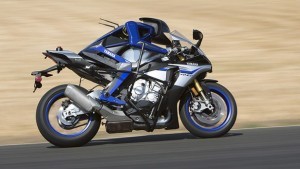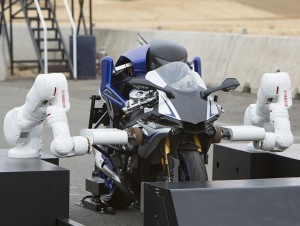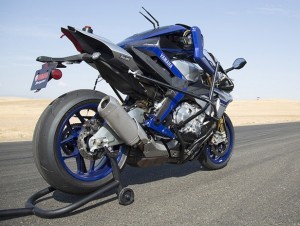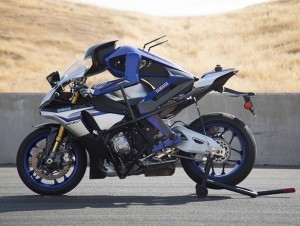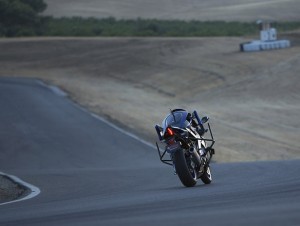It’s been two years since Yamaha’s R1-riding Motobot challenged MotoGP GOAT Valentino Rossi to a lap time duel. And now, the race has been run, at California’s Thunderhill raceway.
Riding a motorcycle is hard, even at the “average dude” level. That’s why it’s so much fun. There’s just so much more to take into account than when you’re behind the wheel of a car: lean angle and body position, for starters, as well as clutch and sequential shifters, countersteering, separate front and rear brakes, weight transfer and a much more vivid relationship with traction at both ends of the bike.
There have been numerous efforts to build self-driving race cars, but there are far fewer teams out there taking on the challenge of building a robot-controlled autonomous motorcycle. Yamaha’s Motobot team set itself an absolutely ludicrous challenge on debut: for Motobot to lap a racetrack faster than Valentino Rossi can.
Not the average dude, Rossi himself. A superhuman athlete with 30 years of top-level experience, 9 world titles, a reputation as the greatest racer in history and a finely tuned mind that can squeeze incredible results out of any motorcycle without Ducati written on the side of it. Well, aim for the moon and land among the stars, right?
…Yeah, not quite. Not on the first run, anyway. At the first showdown, held at Thunderhill West in California, Rossi ran a 1:25.740. Not a great time in itself, according to our good buddy Joe Salas of 4theriders.com, who often works as a track photographer at Thunderhill and says he runs 1:25 laps himself on the rare occasion that he busts out the leathers. I have advised Joe to get on the phone to Yamaha’s GP team and take this chump’s seat.
That was a long last paragraph, and I made it long on purpose. Because if you read from Rossi’s lap time at a regular kind of pace, you’d still be waiting for Motobot to cross the line. Its final time: 1:57.504, a little under 32 seconds slower than Valentino. Watch a nice video package here:
Motobot still has huge chicken strips on the sides of its tires. I’d guess it’s running slightly below a learner’s pace out there, which is kind of funny given that Yamaha’s R1 is more or less the signature bike for clueless learners setting themselves up for disaster in my part of the world.
Still, Motobot’s only two years old, and I’d wager it would kick the butt of any human toddler you could find to put up at this point. But the idea that it’ll take Rossi’s times down in its current form is a bit ridiculous.
While Motobot has very precise track positioning sensors, as well as fine control over throttle, brake, clutch, steering and gearshift inputs, its sorta-humanoid form is unable to move around on the bike at all – and that’s a huge part of high-performance riding.
Top level GP riders like Rossi hang so far off the inside of the bike in the middle of corners that they drag knees, elbows and damn near shoulders on the track, helping to keep the bike itself more upright. They hunch forward under acceleration to keep the front wheel from lifting. They scoot back in the seat and pop up into the airstream to keep the rear wheel on the ground under braking, and add wind resistance to help scrub off speed. They dangle the inside leg off the bike under particularly extreme braking to … well, I’m not exactly sure why they do that, but they all seem to think it helps them go faster. GP level riding is an intensely physical sport; the rider’s backsides barely touch the seat.
In Motobot’s current form, it’s glued to the bike, incapable of doing any of these things. That will limit its acceleration, braking and corner speeds. Now, given the amount of tire it’s still not using, it looks like there’s still 15 or 20 seconds per lap to be gained before it hits the limit of the bike and the tires. If it gets there, Motobot will probably be beating the likes of me: a decent enough rider who’s just crap on a racetrack.
But even if it does get up to Rossi’s outright lap time, it still knows little about managing tires over the length of a race, taking advantages of opponents’ weaknesses, overtaking, blocking passing opportunities, delivering the people’s gumboot to Spanish troublemakers, pulling awesome one-leg-behind-the-other victory wheelies or choosing the perfect victory lap pillion.
Either way, there’s still something incredibly impressive about Motobot – not just that it’s getting around racetracks and hitting speeds over 200 km/h, but that the project exists at all.
I mean, the world is crying out for self-driving cars. They will solve countless transport problems, making the roads safer, cheaper and more efficient than ever before. They are poised to spearhead the next great transport revolution.
But nobody has ever asked for a self-riding motorcycle. What’s the point? It’s too much fun riding one yourself. Maybe a robo-courier, or an absolute last-resort robo-moto-taxi option that can get you through town when the traffic’s bad. But by golly you’d need some melon-sized cojones to jump on one of those. Just ask anyone who’s been through Bangkok on the back of a taxi scooter. I shudder just thinking about it.
Yamaha, for its part, believes Motobot will pay dividends as a learning center and test bed for future motorcycle safety technology, ideas that might make it through into production models one day.
I’m not so sure. I think this little fella might end up being a goal unto itself, a pure moon-shot technology challenge. And in that spirit, I’m right behind it. The more a robot can learn about how a truly talented human rides a motorcycle, the more we can celebrate just how special those humans who can control these things really are, and how magnificently complex the godly task of thrashing a motorbike really is.
And while Rossi beat the metal pants off a 2 year old Motobot, how much money would you put on the fleshy GOAT in five years’s time? What about 10? Food for thought. Enjoy an explanation of some of the tech inside Motobot and the thinking behind the project in a second, longer video below:
Source: newatlas.com
Ask me anything
Explore related questions
